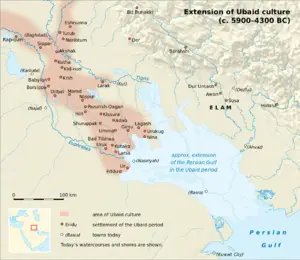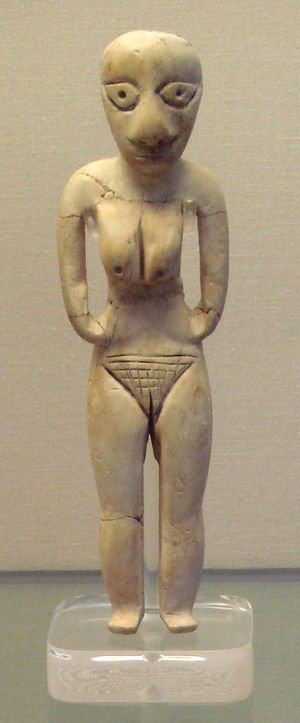When did Social Inequality Develop in the Ancient World
Social inequality has been pervasive throughout the world for the last several hundred years. If anything, we see that differences in wealth and status between individuals in societies have increased over the last few decades.[1] Although some form of inequality is often pervasive in nearly every society type, here the intention is large disparity in wealth and social status that is noticeable in regards to material record. Given this, how did we get to this point and where are the origins of social inequality? To answer this is helps us see if social inequality is a natural consequence for societies or perhaps it is just one avenue humans have developed under but has since become pervasive.
Contents
Origins
The earliest evidence for social inequality come from southern Mesopotamia and southern Egypt (i.e., Upper Egypt). The two cultures that seem to have characteristics of social inequality were the Mesopotamian Ubaid (6500-3800 BCE) and Egyptian Badarian (5000-4000 BCE) cultures.[2][3] During this time, many other cultures in the Near East had adopted agriculture and began to live in villages. What that indicates is that agriculture, by itself, is not a cause of social inequality. What that indicates is that agriculture, by itself, is not a cause of social inequality. However, one possible factor in social inequality becomes evident in cases of high population growth, which the Ubaid seems to characterize, as sites became larger on average.[4] Nevertheless, this is not universally accepted, as some scholars suggest some high population societies did not have vast social inequality. The Ubaid itself did not show evidence of inequality until the later parts of the period.
Ubaid
What this suggests is that there might not be a clear reason as to why humans begin to have large-scale social inequality. Whatever the reason may have been, the evidence for social inequality is evident by the 6-5th millennium BCE. Perhaps some of the clearest evidence for this in the Ubaid culture (Figure 1) comes from the development of religious institutions. Here, we begin to see large temples, specifically at the site of Eridu in southern Mesopotamia, gaining much greater levels of wealth and resources, not to mention its architectural size increases substantially from previous periods, than other institutions or individuals in society.[5] Larger structures, perhaps administrative buildings, also begin to emerge in settlements, such as at Tell Abada, that are also separated from other parts of settlements, showing that these individuals or institutions began to be separated from others. This physical separation, distinct through walls and also much larger structures within the walls, becomes a hallmark in Mesopotamian societies even in later periods.[6]
Structures that begin to show differences in size and distinctive differences also begin to have greater evidence for administration. This is noticeable through objects such as seals and sealings, which likely indicates these large structures began to accumulate more goods, which required a form of control and organization utilizing seals. Large institutions, at least by the next period (called the Uruk; 4000-3100 BC), became one of the main employers of labor, suggesting that the accumulation of resources in larger administrative structures further accelerated social inequality where wealth was flowing to these elites, utilizing their wealth to employ other individuals.[7] In addition, as warfare became established in society, slavery soon appeared. Slavery may have also developed as a form of punishment for debt.
Badarian Culture
While the Ubaid was developing into a society where inequality emerged, in Egypt during the late 5th millennium BC levels of social inequality are also evident. However, unlike southern Mesopotamia, here we see inequality emerging based on how individuals were buried. Settlements in the Badarian culture are largely unknown; therefore, graves are used as indicators of wealth and status individuals have (Figure 2).[8] From this, it is clear that some graves showed large differences in wealth access and presumably status. Some graves begin to have ivory combs and other precious objects buried in them, while other graves show more simple finds or few finds. Grave sizes also begin to get bigger for a restricted number of individuals, suggesting these individuals had more access to resources during their lifespan. Individuals with wealthier graves also seem to be buried separately from other individuals, suggesting members of society began to have different levels of status attributed to them.
Similar to the Ubaid and Uruk cultures, the Naqada culture (4400-3000 BC) succeeds the Badarian culture and social stratification appears to accelerate where differences in grave sizes and richer graves are evident some graves.[9] It is also in this period that writing first develops in Egypt, where individuals of high status appear to have written symbols or tags associated with their graves, perhaps serving as personal name indicators or status symbols.
Spread of Social Inequality
What appears to have happened is that these two regions in southern Mesopotamia and Egypt developed social inequality through preferential treatment of given individuals or elites. Then, these societies began to both become influential in the wider region. The Ubaid began to expand to areas in northern Mesopotamia, the Persian Gulf, Anatolia, and Iran. Meanwhile, the Badarian culture influenced the Naqada culture, which then spread across Egypt, in particular the north. What were more egalitarian societies composed of hunting and farming lifestyles began to transform where status and differences becomes the norm.[10] This process was not rapid, but seems to have occurred throughout the 4th and 3rd millennium BC in large parts of the Near East and Egypt. In essence, it seems cultures that contained levels of social inequality spread and influenced regions and cultures that had less evidence for social inequality in previous periods.
Conclusion
Social inequality does not seem to be a natural development in many parts of the word, where often we see societies are often configured differently into more egalitarian structures, although there might be differences in status among individuals. However, major differences between individuals are first noticeable in southern Mesopotamia and Egypt. These societies spread and eventually established the societies we consider to be the first complex societies that were composed of urban populations with established government and writing systems. Perhaps social inequality led to the path of rising social complexity, where demands of wealth and resources led to expansive societies that also developed leadership that had even greater status than other individuals. This could have given rise to kings in Mesopotamia and Pharaohs in Egypt.
References
- ↑ For more information on modern social inequality, see: Dorling, Danny. 2015. Injustice: Why Social Inequality Still Persists. Revised ed. Bristol: Policy Press.
- ↑ For information on the rise of the Ubaid culture, see: Carter, Robert A., Graham Philip, University of Chicago, and Grey College (University of Durham), eds. 2010. Beyond the Ubaid: Transformation and Integration in the Late Prehistoric Societies of the Middle East. Studies in Ancient Oriental Civilization, no. 63. Chicago, Ill: Oriental Institute of the University of Chicago.
- ↑ For more information on the Badarian culture, see: Shaw, Ian, ed. 2003. The Oxford History of Ancient Egypt. New ed. Oxford ; New York: Oxford University Press, pg. 39.
- ↑ For more information on Ubaid and population size, see: Midlarsky, Manus I. 1999. The Evolution of Inequality: War, State Survival, and Democracy in Comparative Perspective. Stanford, Calif: Stanford Univ. Press.
- ↑ For evidence of religious structures, and likely institutions, gaining greater power and authority in the Ubaid, see: Stein, Gil. 1994. “Economy, Ritual, and Power in Ubaid Mesopotamia". In: Chiefdoms and Early States in the Near East: The Organizational Dynamics of Complexity, edited by Gil Stein and Mitchell Rothman. Madison (WI), pg. 35-46.
- ↑ For further information about Tell Abada, see: Jasim, Sabah Abboud, and Joan Oates. 1986. “Early Tokens and Tablets in Mesopotamia: New Information from Tell Abada and Tell Brak.” World Archaeology 17 (3): 348–62. doi:10.1080/00438243.1986.9979975.
- ↑ For information on the Uruk, see: Rothman, Mitchell S., ed. 2001. Uruk Mesopotamia & Its Neighbors: Cross-Cultural Interactions in the Era of State Formation. 1st ed. School of American Research Advanced Seminar Series. Sante Fe, NM: School of American Research Press.
- ↑ For information on Badarian culture graves in Upper Egypt, see: Lloyd, Alan B. 2014. Ancient Egypt: State and Society. First edition. New York: Oxford University Press, pg. 36.
- ↑ For information on the Naqada culture, see: Bard, Kathryn A. 2007. Introduction to the Archaeology of Ancient Egypt. Malden, MA: Blackwell Pub.
- ↑ For information on the spread of social inequality for Mesopotamian and Egyptian societies and beyond, see: Yoffee, Norman. 2004. Myths of the Archaic State: Evolution of the Earliest Cities, States and Civilizations. New York: Cambridge University Press.
Admin, Maltaweel and EricLambrecht

